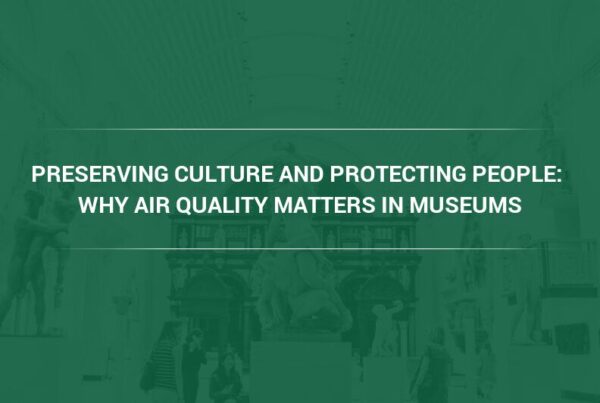The COVID-19 pandemic highlighted the significance of indoor air quality (IAQ). With people spending approximately 90% of their time indoors, ensuring clean and healthy indoor air is crucial for the safety, comfort and well-being of the building occupants.¹ For educational institutions, IAQ plays a vital role in the quality of teaching and learning, as well as student cognition and performance. To improve IAQ throughout their campus, universities must adopt building management programs that include air ventilation and filtration strategies.
Pollutants that contaminate universities
Gaseous contaminants, volatile organic compounds (VOCs) and airborne particulate matter are the main air pollutants found in university settings. They are generated from cleaning supplies, pesticides, building materials and furnishings, mold, viruses, dust, dirt and smoke. Particulate matter is especially harmful as it can penetrate the lungs and brain, causing severe health problems.
These air pollutants can have various adverse effects on students, faculty and staff, including headaches, allergic reactions, eye irritation, itchy skin, bronchitis, fatigue and discomfort that results in higher absenteeism and poor concentration.
Some individuals may experience sick building syndrome, characterized by adverse symptoms when entering a building that subside when they leave. Long-term exposure to poor IAQ can result in serious health effects such as chronic respiratory diseases, pneumonia, cardiovascular problems and even cancer. More than 5 million people die every year prematurely from illnesses attributable to poor IAQ.²
Research shows that poor indoor air damages our cognitive abilities.³ Prolonged exposure to poor air has been linked to a 27% higher risk of cognitive dysfunction compared to the general population.
Compliance requirements
To address IAQ problems and prevent adverse health consequences, university facility and maintenance managers must respond effectively with air quality programs. Educational institutions also are obliged to adhere to ASHRAE standards and EPA building codes for IAQ while seeking new ways to sustainability by improving IAQ.
While the EPA regulates IAQ through the Indoor Air Quality Act of 1991,⁴ ASHRAE Standard 62.1 Ventilation for Acceptable Indoor Air Quality⁵ outlines minimum ventilation rates and other measures to maintain IAQ. The National Institute for Occupational Safety and Health also provides a self-inspection checklist with recommendations to schools in addressing IAQ issues.⁶ Although these guidelines are not mandatory, non-compliance can result in financial loss due to health-related claims and potential building damage.
IAQ strategies
University IAQ strategies should incorporate air ventilation and filtration best practices to mitigate the spread of airborne particles, VOCs and other pollutants that contaminate the air. Ventilation systems are essential as they circulate air by removing stale air and introducing fresh air to dilute and displace air pollutants. While ventilation provides the necessary oxygen, air filtration systems capture airborne contaminants, removing them from the air so that they do not enter the environment.
It’s doubtful a single air filtration solution will work in all the buildings and spaces found in a typical university setting. It takes a tailored approach to select the optimum air filter by considering the type of air handling equipment, the local environmental conditions, , an understanding of the occupancy levels, and what’s required to comply with state, local and school district regulations.
Classrooms and lecture halls
Classrooms and lecture halls frequented by large groups of people throughout the day should use demand-controlled mechanical ventilation systems to adjust airflow based on occupancy. Often, ventilation air into these spaces is through a single-stage filtration system and while a two-stage system offers better filtration, there are filter options for single-stage units that significantly improve the quality of air.
The CDC, OSHA and ASHRAE recommend using MERV-13 air filters as the minimum filter efficiency for HVAC systems. These filters have a Minimum Efficiency Reporting Value (MERV) of 13, capturing 85% of particles 1 micron and larger.
The AQ13 high capacity pleated filter from Camfil meets MERV 13 requirements and offers twice the service life of competitive filters. The Hi-Flo ES also meets MERV 13 requirements and is a good choice for larger air handling units that are difficult to service (requiring a ladder or other assisted device) as it requires fewer changes and is packaged in such a way to allow for multiple filters to be carried by one person.
Buildings with less efficient natural ventilation would benefit from portable air purifiers equipped with particulate and molecular filters to remove dust, contaminants and airborne particles. The CamCleaner CC500 fills the requirement as a portable air purifier with high-efficiency particulate absorbing (HEPA) filtration. It does a good job dealing with local air quality issues.
Libraries and study areas
To maintain a quiet study environment, a low-noise HVAC system can be used along with MERV 13 air filters for air filtration. Additionally, air purifiers equipped with activated carbon filters can supplement the HVAC system to remove odors and volatile organic compounds.
Dorms
In dormitories, ceiling and exhaust fans can enhance air circulation to prevent stuffiness. A minimum of MERV 13 air filter should be used to capture smaller mold, allergens, bacteria and virus particles. Dehumidifiers also can help to maintain appropriate indoor levels, especially in humid climates.
Dining halls/gyms
Molecular filtration is recommended to control gases and odors generated in dining halls and gyms. Camfil CityPleat filters are suitable for these areas as they remove particulates, gases and odors with better initial removal efficiencies and offer a longer lifetime against molecular contaminants.
HVAC systems should provide sufficient ventilation to accommodate the high occupancy during mealtimes. The use of commercial-grade exhaust hoods along with ventilation systems can help manage smoke, grease, and odors. Adhere to your local health department guidelines for kitchen ventilation and air quality when choosing a ventilation/filtration system.
Gymnasiums and recreation halls need increased ventilation rates to handle higher levels of CO2 and humidity produced during physical activities. Demand-controlled ventilation can be used to adjust airflow based on occupancy and activity levels.
In all these spaces where a minimum of MERV 13 filters are recommended, it is advisable to work with an experienced air filtration expert to determine if the air handling units can handle higher MERV-rated filters. Increasing to MERV 14 significantly improves the filtration of sub-micron particles.
Laboratories
Laboratories are unique spaces and require specialized ventilation systems separate from general building HVAC systems to prevent cross-contamination. Specific areas may employ fume hoods and local exhaust ventilation to control exposure to hazardous chemicals.
Labs usually require a minimum 99.97% filtration efficiency at 0.3 microns, which can be achieved with filters such as Camfil’s XH Absolute high capacity HEPA/ULPA-grade filter or the Absolute VG HEPA V-bank air filter, which has a surface area twice the size of a standard HEPA filter and is certified to a minimum efficiency of 99.99% at 0.3 microns.
Multi-stage filtration
When air handling units are configured to hold multiple stages of air filtration, building managers now have many different options available. Two stages of filtration allow these systems to purify the air to the highest standard by using a combination of different filters targeted to remove specific contaminants such as allergens, mold and odors. They also prove cost-effective by ensuring the final filter lasts longer, which reduces maintenance costs and other related operational costs such as energy, and extends the period of air purification until needing to replace or clean filters.
The Camfil Durafil ES3 high-performance V-bank filter can be used as a second-stage filter to reduce total energy consumption. It is designed to have an optimum contaminant loading curve, ensuring consistent particle capture efficiency to protect building occupants from contaminants. When removing fine particulate matter, the MERV 16A version offers the highest efficiency while carbon filters like the Camfil CityCarb I are efficient in removing both solids and gaseous contaminants.
Expanding IAQ strategies to different areas within a university requires a tailored approach based on specific environmental and occupancy conditions. What works for the classroom may not be a sufficient solution for the dining hall or gymnasium. Evaluate each area to determine requirements. Making IAQ a priority makes students, faculty and staff a priority by ensuring their health and safety when on campus.
About Camfil Clean Air Solutions
Camfil offers air filtration solutions that address all air quality issues in educational institutions. For more than half a century, we have been helping people breathe cleaner air. As a leading manufacturer of premium clean air solutions, we provide commercial and industrial systems for air filtration and air pollution control that improve worker and equipment productivity, minimize energy use, and benefit human health and the environment. We firmly believe that the best solutions for our customers are the best solutions for our planet, too. That’s why every step of the way – from design to delivery and across the product life cycle – we consider the impact of what we do on people and the world around us. Through a fresh approach to problem-solving, innovative design, precise process control, and a strong customer focus we aim to conserve more, use less, and find better ways – so we can all breathe easier.
The Camfil Group is headquartered in Stockholm, Sweden, and has 30 manufacturing sites, six R&D centers, local sales offices in 35+ countries, and about 5,600 employees and growing. We proudly serve and support customers in a wide variety of industries and communities across the world. To discover how Camfil USA can help you to protect people, processes, and the environment, visit us at www.camfil.us/.
¹https://www.epa.gov/indoor-air-quality-iaq
²https://www.sciencedirect.com/science/article/abs/pii/S0045653520325716
³https://www.cnn.com/2018/08/27/health/air-pollution-cognitive-abilities-intl/index.html
⁴https://www.govtrack.us/congress/bills/102/s455/summary
⁶https://www.cdc.gov/niosh/docs/2004-101/chklists/6indoo~1.htm



